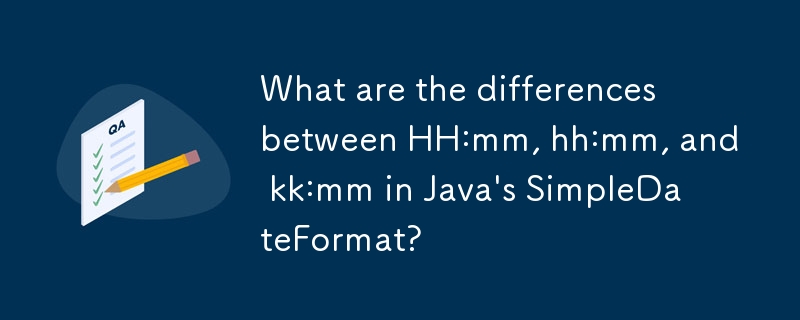Home >Java >javaTutorial >What are the differences between HH:mm, hh:mm, and kk:mm in Java's SimpleDateFormat?
What are the differences between HH:mm, hh:mm, and kk:mm in Java's SimpleDateFormat?
- Patricia ArquetteOriginal
- 2024-11-17 17:03:01588browse

Distinguishing between java Formatting Patterns: HH:mm, hh:mm, and kk:mm
The SimpleDateFormat class in Java provides various format patterns to display dates and times. While the HH:mm, hh:mm, and kk:mm patterns may seem similar, there are notable differences in their representations.
Consider the following Java code snippet:
SimpleDateFormat broken = new SimpleDateFormat("kk:mm:ss");
broken.setTimeZone(TimeZone.getTimeZone("Etc/UTC"));
SimpleDateFormat working = new SimpleDateFormat("HH:mm:ss");
working.setTimeZone(TimeZone.getTimeZone("Etc/UTC"));
SimpleDateFormat working2 = new SimpleDateFormat("hh:mm:ss");
working.setTimeZone(TimeZone.getTimeZone("Etc/UTC"));
System.out.println(broken.format(epoch));
System.out.println(working.format(epoch));
System.out.println(working2.format(epoch));
The output of the provided code is:
24:00:00 00:00:00 05:30:00
Let's break down the differences between these patterns:
- kk:mm: Represents hours (01-24) in a 24-hour format. The output "24:00:00" indicates midnight in this format.
- HH:mm: Represents hours (00-23) in a 24-hour format. The output "00:00:00" denotes 12:00 AM in this pattern.
- hh:mm: Represents hours (01-12) using a 12-hour format with AM/PM designations. However, it's important to note that the code example does not set the format to "hh:mm:ss". Instead, it uses the same format as "working", which is "HH:mm:ss". As a result, the output "05:30:00" is incorrect and should have been "12:00:00" in a 12-hour AM/PM format.
Therefore, understanding the nuances of these formatting patterns is crucial for accurately representing dates and times in Java.
The above is the detailed content of What are the differences between HH:mm, hh:mm, and kk:mm in Java's SimpleDateFormat?. For more information, please follow other related articles on the PHP Chinese website!

